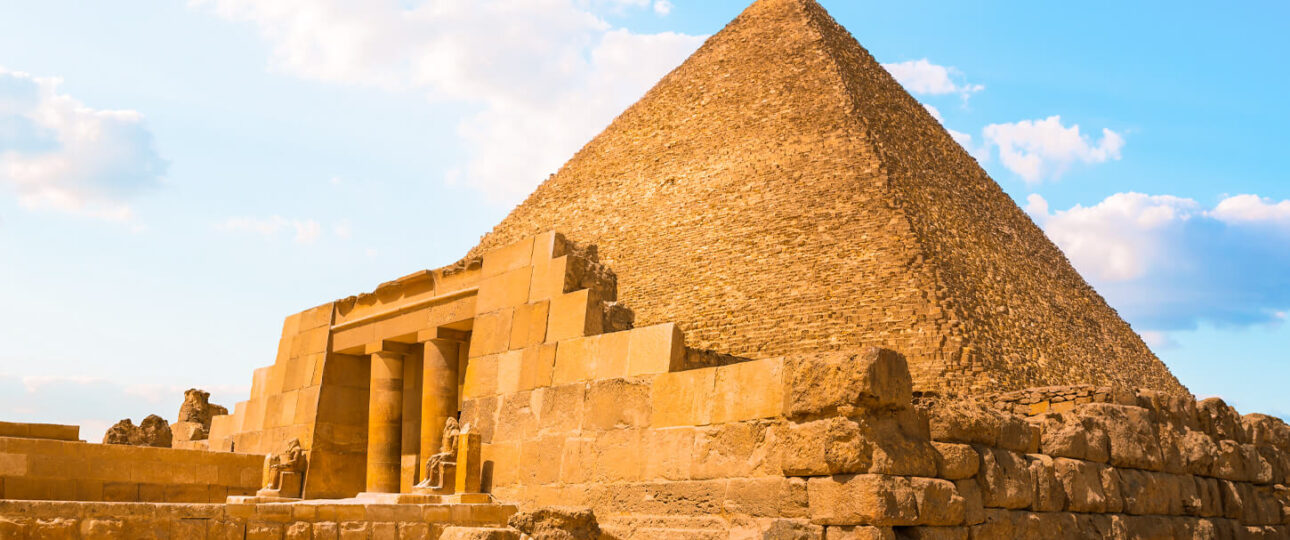Great Pyramid of Cheops: the Wonders of Ancient Egypt
The Great Pyramid of Cheops, known as the Pyramid of Khufu or Giza, is one of the world’s most awe-inspiring and enigmatic architectural wonders. Built during the Old Kingdom period of ancient Egypt, this colossal pyramid is a testament to the ancient Egyptians’ engineering prowess and cultural significance. In this article, we will delve deep into the mysteries and grandeur of the Great Pyramid of Cheops, uncovering its historical context, architectural marvels, and the enduring questions that continue to captivate scholars and tourists alike.
Great Pyramid of Cheops, A Glimpse into Ancient Egyptian Civilization
The Great Pyramid of Cheops is an enduring symbol of ancient Egyptian civilization and the pharaohs’ power and wealth. Let’s explore the historical context of this magnificent structure and its significance.
- Don’t miss out on our Best Time to Travel to Egypt
The Old Kingdom, A Flourishing Era
During the Old Kingdom period, which spanned from approximately 2686 BCE to 2181 BCE, ancient Egypt experienced a period of remarkable stability and prosperity. During this era, the construction of the Great Pyramid of Cheops began.
Pharaoh Khufu, The Visionary Ruler
The Great Pyramid of Cheops was commissioned by Pharaoh Khufu, also known as King Cheops. Khufu was the second pharaoh of the Fourth Dynasty and reigned from around 2589 BCE to 2566 BCE. He envisioned a monument that would serve as his final resting place, demonstrate his divine authority, and ensure his immortality.
Architectural Marvels of the Great Pyramid of Cheops
The construction of the Great Pyramid of Cheops involved an intricate process that showcased the ancient Egyptians’ advanced architectural techniques. Here are some fascinating aspects of its construction:
Massive Scale and Dimensions: The Great Pyramid stood at an impressive height of 481 feet (146.5 meters) and was the tallest artificial structure for over 3,800 years. Its base covers an area of approximately 13 acres.
Precise Alignment: The Great Pyramid is precisely aligned with the cardinal points of the compass, exhibiting the Egyptians’ remarkable understanding of astronomy and geometry.
Limestone Blocks: The pyramid was constructed using an estimated 2.3 million limestone blocks, weighing an average of 2.5 tons each. These blocks were meticulously cut, transported, and fitted together with astounding precision.
Interior Passages and Chambers: The Great Pyramid features a complex network of passages and chambers, including the Grand Gallery, King’s Chamber, and Queen’s Chamber. These spaces serve both structural and symbolic purposes.
Mortuary Temple and Causeway: Adjacent to the Great Pyramid, a mortuary temple and causeway were built to facilitate the pharaoh’s journey to the afterlife.
Unraveling the Mysteries
The Great Pyramid of Cheops has long fascinated scholars and archaeologists, giving rise to numerous theories and unanswered questions. Let’s explore some of the enduring mysteries surrounding this ancient wonder.
How Was It Constructed?
One of the most perplexing questions is how the ancient Egyptians constructed such a monumental structure without modern machinery. While several theories exist, the exact methods used in the pyramid’s construction remain a subject of debate and intrigue.
What Lies Within the Chambers?
Despite extensive exploration and excavation efforts, the purpose of certain chambers within the Great Pyramid remains unknown. The King’s Chamber, in particular, captivates researchers due to its intricate construction and the absence of burial evidence.
Alignments with the Stars, Coincidence or Intentional?
Some scholars propose that the precise alignments of the Great Pyramid with celestial bodies were intentional, serving as a connection between the earthly realm and the divine. Others argue that these alignments were mere coincidences.
Asked Questions for the Great Pyramid of Cheops
What is the Great Pyramid of Cheops?
The Great Pyramid of Cheops is an ancient Egyptian pyramid located in Giza. It was built as a monumental tomb for Pharaoh Khufu during the Old Kingdom period.
How tall is the Great Pyramid of Cheops?
The Great Pyramid stands approximately 481 feet (146.5 meters) tall, making it one of the tallest artificial structures for thousands of years.
How long did it take to build the Great Pyramid of Cheops?
The construction of the Great Pyramid is estimated to have taken around 20 years, employing a massive workforce of skilled laborers.
Is the Great Pyramid open to the public?
Yes, the Great Pyramid of Cheops is open to the public, allowing visitors to explore its interior passages and chambers.
What is the significance of the precise alignment of the Great Pyramid?
The Great Pyramid’s accurate alignment with the compass’s cardinal points suggests the ancient Egyptians’ deep understanding of astronomy and geometry.
Are there any hidden chambers within the Great Pyramid of Cheops? While exploration efforts continue, the purpose and contents of specific sections within the Great Pyramid remain unknown, adding to its intrigue and mystery.
- Also Read Our Landmarks in Egypt
Conclusion
The Great Pyramid of Cheops is a remarkable testament to the ancient Egyptians’ ingenuity, architectural prowess, and cultural significance. Its grandeur and mysteries continue to captivate the world, making it a must-visit destination for those seeking to unravel the secrets of ancient Egypt. As we explore this awe-inspiring structure, we come closer to understanding the historical context, architectural marvels, and enduring questions surrounding the Great Pyramid of Cheops.

